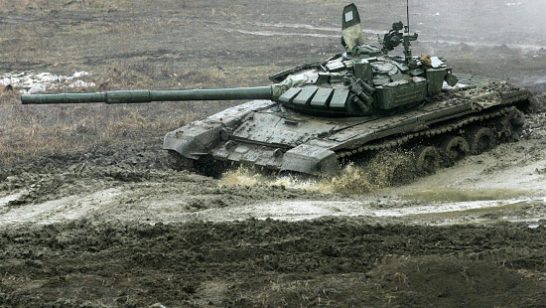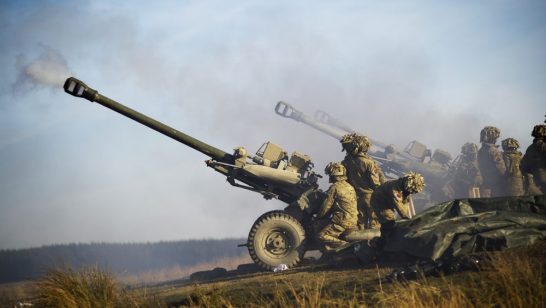
The US and NATO have given their written answers to Russia’s sweeping demands, and the diplomatic back and forth now seems likely to continue through at least one, maybe two or more rounds. But the uncertainty over whether the two sides can find enough common ground to deflate the crisis, while watching each of them intensify its military preparations, utterly dominates everyone’s attention. This drama obscures two fundamental questions. How could it happen that – nearing a quarter century after the tensions of the Cold War ended – the peace of Europe is again fundamentally imperiled? And, beyond the immediate and urgent question of how the worst is to be averted, the larger, neglected question is: what is necessary if the desiccated hopes of a Europe “whole and at peace,” the rosy expectation of leaders as the Soviet Union crumbled, are to be revived?
Following the collapse of the Soviet Union, the Euro-Atlantic security community stretching from “Vancouver to Vladivostok” that US, European and Russian leaders promised to build, exceeded their creativity and, more importantly, their political will. Amidst the debris of a fallen empire, it may have been unrealistic to expect a psychologically wounded Russia to reassure rather than strong-arm its unwelcome new neighbors. It may also have been natural for a self-satisfied West to turn its attention to new preoccupations. The price paid, however, had become evident a decade later when efforts like the Euro-Atlantic Security Initiative, a commission of senior ex-officials from the United States, Europe, and Russia, surveyed the damage and issued its appeal. Reading their report ten years to the day from its issue, one can only rue how different today’s Europe would be had their warning and urgings been heeded.
The price paid for the indifference to that report should remind contemporary leaders of the price they will pay if they too, once again, avoid tackling the root source of the problem and focus only on somehow prevailing in the escalating crisis over Ukraine. In Moscow, Washington, and Brussels, they will be substituting a fool’s errand, with potentially tragic consequences, for efforts, however difficult and constrained, directed at building a semblance of the Europe their predecessors promised to construct when given a chance at the Cold War’s end.
The three-level challenge
Answering the second basic question is harder, because it entails dealing with a tangled three-level challenge. The challenge resembles a Russian matryoska doll. The outer doll, the most fundamental level of the challenge, is in finding a more durable, balanced and mutually acceptable architecture for European security. The middle doll requires identifying a path to a workable resolution of the Ukrainian question. The small explosive third doll—explosive because it could blow up the entire doll—urgently demands escaping the current crisis.
If there is good news, it is that the parties appear to have been jolted back to recognising that the current crisis needs to be addressed in the larger European security context. The problem is that they have long ago forgotten how to do this and what rudimentary thoughts they have appear to be far apart. Moreover, progress on the second level, Ukraine, is frozen and little suggests that the parties concerned know how to unfreeze it.
The current tension could be defused with two relatively straightforward steps Robert Legvold
That said, at the third level – that of the immediate crisis – the current tension could be defused with two relatively straightforward steps. First, Russia, as a token gesture, would return back to their home bases some of the upwards of one hundred tactical battalion groups that it has moved forward to the Yelnya, Boyevo, and Novoozernoye deployment areas, and temporarily postpone the menacing large-scale exercise on Ukraine’s border scheduled for mid-February; NATO members would scale back military exercises near the Russian border, and the United States would pause any decision to send to Europe the portion of 8,500 troops now on alert. Second, leaders would, despite the looming prospect of failure, intensify their diplomatic efforts to find some—any—steps leading away from the path they are on.
But that is where the matryoska metaphor breaks down, because the three levels are not separate. They are interlocking dolls. Trying to defuse the current tension by simply discussing the concerns that led to the crisis, without effective concessions on both sides, will solve little. Conversely, it will guarantee the prospect of renewed trouble in the future. One needs to wrestle with the obstacles where the third and second levels are fused. Think in terms of a daisy chain. Avoiding a Russian invasion of Ukraine and the wreckage that that will impose on an already deeply stressed Russia-West relationship is an immediate and urgent goal. But minimal steps to do this run headlong into elements enmeshed in the hard intractable problems surrounding a resolution of the larger Ukrainian question.
The linkage is in the dual demands of Russia at the heart of the current crisis: no Ukraine in NATO and, short of that, no NATO in Ukraine. Neither of these have a reasonable answer without movement on the larger Ukrainian question. Moreover, the Ukraine-NATO question is but the inflamed incarnation of Russia’s (and in particular, Putin’s) frustration over NATO’s broad, gradual movement closer to Russian borders, of which the pledge to remain open to more members is the most sensitive part. At present, however, NATO is dug in on what it sees as the fundamental principle of an alliance open to any state that qualifies for membership, including Ukraine and presumably Georgia, Moldova, and Armenia.
Conceivably NATO might weigh, as a number of analysts in the United States and Russia have urged, declaring a moratorium of ten or more years on considering the question. But even as an intermediate step, giving the sides time to grapple with NATO’s future scope and role, the chance of its acceptance depends on whether Washington, Brussels, and Moscow are prepared to deal with the outer doll, with the top of the daisy chain, with the requirements for a more stable European security order.
On the second demand, the United States and NATO allies might make plain that they do not intend to turn Ukraine into a NATO bridgehead by taking steps to demonstrate that their training facilities in Ukraine will not be converted into operational bases nor will the arms they supply to Ukraine cross critical thresholds, if, in turn, Russia promises to thin out its forces on the Ukrainian border and withdraw Russian soldiers and officers supporting the 1st (Donetsk) and 2nd (Luhansk) Army Corps.
None of this, however, can happen until Moscow feels confident that the Ukrainian government will not seize the opportunity that these steps would create to crush the separatist governments militarily. Nor can it happen until Kyiv and its western supporters trust that Russia no longer seeks to exploit the ongoing military instability in Donbas to constantly wrong-foot them. For that, the eight-year Ukrainian stalemate must be broken.
Breaking the Ukrainian stalemate
Breaking it won’t be possible within the current Minsk framework. That framework’s core requirements and their sequencing—local elections under special provision for local autonomy, restored Ukrainian control over its border with Russia, and then constitutional reform guaranteeing the rebellious regions a special status—have not not been and will not be attainable.
Elements of the Minsk II protocol are important and doable, such as solidifying the ceasefire line, introducing neutral peace keeping forces, and providing for humanitarian assistance. But their pursuit should be woven into a larger goal—that of normalizing Russian-Ukrainian relations. Normalization would focus on assuring Ukrainian access to the Sea of Azov through the Kerch Strait, establishing confidence building measures (CBMs) that give transparency and predictability to each side’s military actions, facilitating rather than blocking water supplies to Crimea, repairing desirable industrial and economic ties that were severed over the last several years, dampening the information war each conducts against the other, and relinking multiple agencies of the two governments in dialogues aimed at finding areas of potential cooperation. These parts of the Minsk agreement should figure both as a necessary component and a potential beneficiary of the process, but not as its precondition.
Normalizing Russian-Ukrainian relations as goal, however, should not be represented as replacing the Minsk process. Both sides, for quite contrary reasons, insist that Minsk must remain the framework within which progress toward a resolution of the Ukrainian question is achieved. But, while the parties try fitfully to overcome the deeply entrenched obstacles to any meaningful implementation of the Minsk agreement’s core provisions, efforts to ease a deepening adversarial relationship by exploring constructive measures that serve the interests of both countries should be thought of as the more practical way to begin surmounting the Ukrainian security problem and with it a principal lacuna in European security
Only the naïve, however, would think that in their present mood the Russian and Ukrainian leaderships have any desire to move in this direction. So the role of the United States and its European allies is critical. They should recast their stale sanctions regime toward Russia, and redirect it toward encouraging these steps and rewarding them when taken. Toward Ukraine they should redeploy their aid not only to foster domestic reform and bolster its defence, but to induce a readiness to reciprocate any constructive steps taken by Russia.
Recrafting the European security structure
Here, however, one arrives at the top of the daisy chain. Ultimately, achieving a normalised Russian-Ukrainian relationship and the two countries at peace, let alone a resolution to the status of Donbas, depends on a recrafted European security structure and the dynamic it engenders. A Euro-Atlantic security community from “Vancouver to Vladivostok” is a faded fantasy. However, a shift of momentum, away from a remilitarised confrontation cutting through Europe’s most unstable regions from the Arctic to the Black Sea, should not be beyond imagination. Nor should other steps to make all of Europe safer and less tension-filled be out of reach.
Among these steps could be a return to some form of arms control limiting certain types of armament and units forward deployed, a reinforced Vienna Document constraining the size and nature of exercises, a reaffirmation of NATO’s pledge that it has “no intention, no plans, and no reason” to deploy nuclear weapons on the territory of any new NATO member, and a prohibition on deploying intermediate-range ballistic missiles (IRBMs) in Europe, as well as a renewed effort to reduce the threat from sub-strategic nuclear weapons. These steps would increase the security of both sides as well as the countries caught between. The US and NATO in their written responses to Russian demands have offered to explore steps of this kind, and, if the Russian side sees them as potentially meeting its immediate security concerns, this may allow each side to begin backing away from the most threatening actions they are now taking and allow the diplomatic process to go forward.
Further, information warfare, including cyber interference in the politics and into the infrastructure of other countries, which is both a cause and consequence of poisoned relations, can and should be curtailed. If efforts to get a handle on this problem are framed within a broad policy aimed at easing tensions between the two sides, rather than reducing them to a test of ever more severe retaliatory measures in a deepening confrontation, almost certainly the odds of success would increase. Similarly, focusing harder on de-politicising energy security in Europe and on measures protecting the legitimate interests of both suppliers and consumers as well as transporters, complicated as this may be, makes more sense than continuing to treat this as a battleground. And the Arctic should be approached as an opportunity together to enhance mutual security, equitable access to resources, and, above all, effective measures to mitigate the damage from climate change.
None of this, however, will remove from Europe the fundamental uncertainties and sources of tension brought to a boil by this and a potentially permanent series of Ukrainian crises, unless the impact of the current crisis forces leaders on both sides to do more than strive for security enhancing measures. Instead they need to stare hard at what needs to change to usher Europe into a safer and more secure future. For the US and NATO, this means reassessing the wisdom of insisting that principle requires the alliance to remain open to further expansion. The reassessment would not be to please Russia, but, as Michael Kimmage has written: “because NATO suffers from a severe design flaw: extending deep into the cauldron of eastern European geopolitics, it is too large, too poorly defined, and too provocative for its own good.” The promise of adding more members from this troubled region is, as Kimmage says, either purely “aspirational” or, worse, “insincere,” but either way it further weakens the alliance. Granted that facing up to this reality in the midst of the Ukrainian crisis is neither feasible nor wise, but if the future of NATO remains at the heart of the Russia-West impasse over European security, it must in some fashion be confronted.
The foundation for European security should be mutual security, not unilateral military advantage standing guard over spheres of influence Robert Legvold
It is not unthinkable that the current negotiations, if skillfully conducted, could produce limited success along the lines outlined in the US and NATO written response to Russian demands, and, thus, open the way to a tentative but more fundamental exploration of a recasting of European security architecture. If a NATO commitment to close its doors is a critical part of this, however, it is only a part of it. The foundation for European security should be mutual security, not unilateral military advantage standing guard over spheres of influence. And mutual security should be for all. If Russia’s security is guaranteed against the threat that it sees from NATO, it must in turn guarantee the security of its European neighbors, including the new “lands in between,” Europe’s dangerous 21st century security vacuum. That requires shifting from, in time of need, a strategy of coercion to a more enduring one of reassurance. Such a strategy would need to be embodied in the restraint with which Russia readies and deploys its military power. But it also depends on how generously, beyond its own security preoccupations, it empathises with those of its neighbors, and they with its. Which, it should be noted, brings us back to the second matryoska doll. Setting the goal of normalising Ukrainian-Russian relations is not simply the best, albeit exceedingly difficult, path to resolving the Ukrainian question. If achieved, it would be a pillar in the larger European security setting.
Each level of this daisy chain looked at separately may appear hopelessly immune to change, making the suggestions offered here seem sadly impractical. But if one steps back from considering each narrowly and reflects on the stakes involved when the three levels are approached as a whole, policymakers in Moscow, Washington, and European capitals might have second thoughts about their current fractured and self-absorbed way of defining and addressing the Ukrainian crisis. In Washington and Moscow, they might even pause their single-minded prosecution of their currently congealed Cold War and think harder about a workable path out of it. Otherwise, the unknowns that lie ahead are potentially large and dark, maybe even the “guns of August.”
This is a revised and updated version of an article published by The National Interest on January 7th. We thank TNI for their kind permission to publish this new version.
The opinions articulated above represent the views of the author(s) and do not necessarily reflect the position of the European Leadership Network or any of its members. The ELN’s aim is to encourage debates that will help develop Europe’s capacity to address the pressing foreign, defence, and security policy challenges of our time.
Image: Flickr, NATO



